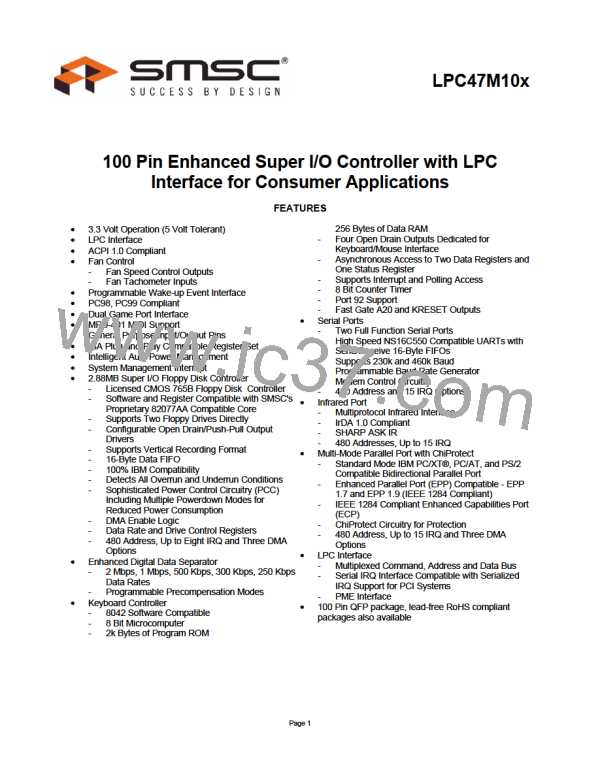Note 2: GP36-GP37 and GP40 should not be connected to any VTR powered external circuitry. These pins are not
used for wakeup.
Note 3: GP60 and GP61 have LED functionality which must be active under VTR so its buffer is powered by VTR.
Note 4: These pins can be used for wakeup events to generate a PME while the part is under VTR power (VCC=0).
Note 5: These pins cannot be used for wakeup events to generate a PME while the part is under VTR power
(VCC=0). The GP32, GP33 and GP53 pins come up as output and low on a VCC POR and hard reset.
These pins revert to their non-inverting GPIO output function when VCC is removed from the part.
Note 6: GP43 defaults to the GPIO function on VCC POR and Hard Reset.
EITHER EDGE TRIGGERED INTERRUPTS
Six GPIO pins are implemented such that they allow an interrupt (PME or SMI) to be generated on both a high-to-low
and a low-to-high edge transition, instead of one or the other as selected by the polarity bit.
The either edge triggered interrupts (EETI) function as follows: If the EETI function is selected for the GPIO pin, then
the bits that control input/output, polarity and open collector/push-pull have no effect on the function of the pin.
However, the polarity bit does affect the value of the GP bit (i.e., register GP2, bit 2 for GP22).
A PME or SMI interrupt occurs if the PME or SMI enable bit is set for the corresponding GPIO and the EETI function
is selected on the GPIO. The PME or SMI status bits are set when the EETI pin transitions (on either edge) and are
cleared on a write of ‘1’. There are also status bits for the EETIs located in the MSC_STS register, which are also
cleared on a write of ‘1’. The MSC_STS register provides the status of all of the EETI interrupts within one register.
The PME, SMI or MSC status is valid whether or not the interrupt is enabled and whether or not the EETI function is
selected for the pin.
Miscellaneous Status Register (MSC_STS) is for the either edge triggered interrupt status bits. If the EETI function is
selected for a GPIO then both a high-to-low and a low-to-high edge will set the corresponding MSC status bits.
Status bits are cleared on a write of ‘1’. See Runtime Register section for more information.
LED FUNCTIONALITY
The LPC47M10x provides LED functionality on two GPIOs, GP60 and GP61. These pins can be configured to turn
the LED on and off and blink independent of each other through the LED1 and LED2 runtime registers at offset 0x5D
and 0x5E from the base address located in the primary base I/O address in Logical Device A.
The LED pins (GP60 and GP61) are able to control the LED while the part is under VTR power with VCC removed.
In order to control a LED while the part is under VTR power, the GPIO pin must be configured for the LED function
and either open drain or push-pull buffer type. In the case of open-drain buffer type, the pin is capable of sinking
current to control the LED. In the case of push-pull buffer type, the part will source current. The part is also able to
blink the LED under VTR power. The LED will not blink under VTR power (VCC removed) if the external 32kHz clock
is not connected.
The LED pins can drive a LED when the buffer type is configured to be push-pull and the part is powered by either
VCC or VTR, since the buffers for these pins are powered by VTR. This means they will source their specified current
from VTR even when VCC is present.
The LED control registers are defined in the “Runtime Register” section.
Page 107

 SMSC [ SMSC CORPORATION ]
SMSC [ SMSC CORPORATION ]